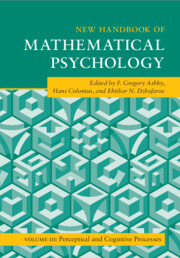Book contents
- Frontmatter
- Contents
- Contributors
- Preface
- 1 Principles and Consequences of the Initial Visual Encoding
- 2 Measuring Multisensory Integration in Selected Paradigms
- 3 Fechnerian Scaling: Dissimilarity Cumulation Theory
- 4 Mathematical Models of Human Learning
- 5 Formal Models of Memory Based on Temporally-Varying Representations
- 6 Statistical Decision Theory
- 7 Modeling Response Inhibition in the Stop-Signal Task
- 8 Approximate Bayesian Computation
- 9 Cognitive Diagnosis Models
- 10 Encoding Models in Neuroimaging
- Index
1 - Principles and Consequences of the Initial Visual Encoding
Published online by Cambridge University Press: 20 April 2023
- Frontmatter
- Contents
- Contributors
- Preface
- 1 Principles and Consequences of the Initial Visual Encoding
- 2 Measuring Multisensory Integration in Selected Paradigms
- 3 Fechnerian Scaling: Dissimilarity Cumulation Theory
- 4 Mathematical Models of Human Learning
- 5 Formal Models of Memory Based on Temporally-Varying Representations
- 6 Statistical Decision Theory
- 7 Modeling Response Inhibition in the Stop-Signal Task
- 8 Approximate Bayesian Computation
- 9 Cognitive Diagnosis Models
- 10 Encoding Models in Neuroimaging
- Index
Summary
Vision science combines ideas from physics, biology, and psychology. The language and ideas of mathematics help scientists communicate and provide an initial framing for understanding the visual system. Mathematics combined with computational modeling adds important realism to the formulations. Together, mathematics and computational tools provide a realistic estimate of the initial signals the brain analyzes to render visual judgments (e.g., motion, depth, and color). This chapter first traces calculations from the representation of the light signal, to how that signal is transformed by the lens to the retinal image, and then how the image is converted into cone photoreceptor excitations. The central steps in the initial encoding rely heavily on linear systems theory and the mathematics of signal-dependent noise. We then describe computational methods that add more realism to the description of how light is encoded by cone excitations. Finally, we describe the mathematical formulation of the ideal observer using all the encoded information to perform a visual discrimination task, and Bayesian methods that combine prior information and sensory data to estimate the light input. These tools help us reason about the information present in the neural representation, what information is lost, and types of neural circuits for extracting information.
Keywords
Information
- Type
- Chapter
- Information
- New Handbook of Mathematical Psychology , pp. 1 - 41Publisher: Cambridge University PressPrint publication year: 2023
Accessibility standard: Unknown
Why this information is here
This section outlines the accessibility features of this content - including support for screen readers, full keyboard navigation and high-contrast display options. This may not be relevant for you.Accessibility Information
- 1
- Cited by
